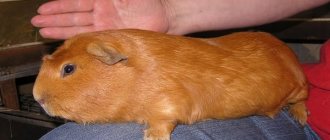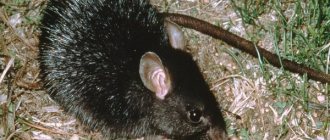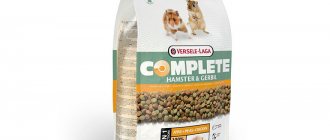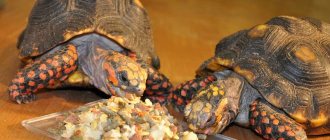Important nuances of hamster pregnancy
Sometimes owners find out that the pet was pregnant only during childbirth. But some animal lovers specifically purchase a pair of rodents of different sexes for breeding purposes.
Unexpected birth
If a hamster gives birth, all other rodents must be removed from the cage immediately.
Over the next 2 weeks, interference in the life of the cubs, penetration into the cage should be minimal.
Refuse cleaning and do not touch newborns. The appearance of foreign odors will frighten the female and may lead her to decide to eat the hamsters.
Planned replenishment
Take care of proper nutrition for the pregnant woman. Her diet includes more protein foods, fruits, vegetables, and also increases the amount of food and liquid due to increased energy costs. It is necessary to regularly change the water in the drinking bowl. It is better to use spring or bottled water, since tap liquid contains a lot of bleach that is harmful to rodents.
The partner and other relatives should be moved to another cage. Neighbors can disturb a pregnant woman and create stress, so before giving birth and during the first weeks after the birth of the cubs, it is better for the female to remain alone.
What do baby jungarikas look like?
Newborn hamsters may not be immediately noticeable, because they are about 2 cm long and weigh 1–2.5 g each. Djungarians are born after about 3 weeks of pregnancy. They have no hair at all, and their skin is very thin, giving the impression that it is transparent.
Did you know? In the wild, a male Djungarian hamster can mate with several females, but only one of them will help during childbirth and care for the offspring.
The blood vessels lie quite close to its surface, so it seems that the babies are colored red. In general, the offspring looks like a pink spot, which, depending on the color, will be dark or light in color; it is constantly seething and strives to spread out. These little creatures have their ears and eyes closed, they are completely helpless, but have a developed sense of smell.
Preparing for an addition
A pregnant female needs:
- Peace. The male should be transplanted into a separate cage no later than a week before the expected birth. During pregnancy, owners should approach the hamster less often and approach the cage only when necessary.
- Changing your diet. You will have to increase the amount of protein, add seeds, vegetables, fruits. The portion size will become larger.
- Cleanliness. You should clean up about a week before giving birth. Add 2-3 times more sawdust. They cannot be changed in the first weeks of the cubs' life.
- Free space. The attractions are being removed; in the near future they will only disturb the animals. It is better to leave the house so that the hamster can hide supplies there.
- Paper napkins or soft toilet paper for the nest. Sawdust is too hard and prickly for children. It is better to provide your hamster with softer material to build on.
Conditions of detention
Proper maintenance will affect the future health of the animals.
Improvement of the cell
When arranging the cage, consider the following aspects:
- Litter. Avoid using patches made of artificial fabric or cotton wool. Newborns may suffocate if exposed to such materials.
- Special security. Make sure that babies cannot get out of the cage on their own. If this does happen, do not pick them up to return them to the house. Better use a spoon.
- Avoid tiers. Select cages with a small distance between the bars so that the baby cannot fall out.
- Drinking bowl. If there is water in an open container, the hamsters may drown. It is better to install a container with a spout through which the animals can independently extract liquid when they grow up a little.
- Calm. The house should be located in a place away from sources of direct bright light. It is better to put the cage in a room inaccessible to children so that noise and constant attention do not disturb the female.
Basic principles of care
More often you have to take care not of newborns, but of their mother. If the hamster has not abandoned the cubs, it is better not to touch the offspring until they grow up. The person will be required to maintain a constant temperature in the room where the cage is located.
. The optimal range is +21…+25°C.
It is better to place food next to the cage so that a hungry female can independently get food through the bars.
Dzungariki
Don't bother the hamster. Stress and nervous tension are deadly for newborn animals.
Syrian hamsters
For this species, the rules of care in the first days of life are the same as for jungarians.
Djungarian hamster cage
The small Djungarian hamster does not require much space. Mainly lives in a cage, aquarium or terrarium. Of course, the larger the area of the home, the better, but with proper design, a small area is enough for it.
The minimum cage size is 30 by 50 cm, but if it is larger, the fluffy will not refuse.
A hamster is very active in nature, so you need to provide him with this opportunity. To do this, use a running wheel, which every rodent should have.
He wants to taste everything. From time to time it is recommended to walk around the apartment. To prevent him from getting lost and chewing on anything, you can buy a walking ball for your hamster. In it, he will be able to walk freely around the apartment and the owner will always find him easily.
Keeping a Djungarian hamster includes cleaning. To do this less often, install a toilet and train your pet to use it. Then it will be enough to change the litter only in the toilet once a day, and clean the cage once a week.
If you plan to place your baby in an aquarium, then choose one with low walls. Otherwise there will be poor ventilation and high humidity. This situation will give a good start for the reproduction and development of bacteria.
Filling the cell
Since teeth grow throughout their lives, the pet must constantly grind them down. For these purposes, the pet store has special mineral stones. Those who cannot afford such a purchase can install a wooden block. If you don't put anything in place, you can see the hamster gnawing on the bars of the cage.
Each cage should have two feeders and a drinker. The first feeder is for dry food, which can stand for a long time; there should always be something there. The second is for products that quickly deteriorate; it must be empty. Make sure your pet eats everything and doesn’t leave it behind. If there is anything left, you need to pick up the remains before they start to spoil.
A drinking bowl is a mandatory attribute of each cell. Don’t listen when they tell you that juicy foods are enough for dzhungarika. This is not true, no matter how many there are, fresh water must be available.
You can make a house for a hamster yourself or buy it. Food will be stored there and your pet will sleep there.
Of course, there must be bedding in the cage. It serves for the comfort of the animal and absorption of odors. If a rodent relieves itself anywhere, the filler will immediately absorb everything. There is a very wide choice on the market, but we recommend using corn. It needs to be changed less often than others, and it absorbs smell and liquid better.
Features of keeping several individuals in one cage
It is better to keep pets separately. When two or more live in a cage, they can often conflict with each other. As a result, there will be injuries, sometimes this situation leads to death. Even with a positive attitude, the instinct to protect one's own territory remains. Therefore, over time, you will have to resettle or give one individual to someone. You can try to divide the home into two parts and fence them off, but the cage should be large enough so that there is enough space for both.
Features of cultivation
Follow a number of rules to avoid harming small hamsters. Some of the litter may die even with proper care. This phenomenon is considered normal: only weak, sick individuals die.
Development of small pets
Hamsters grow and develop quickly. Already by the 2nd day of life, the skin turns pink, then darker spots appear, the color of which depends on the color of the breed. By the first week of life, reddish, gray or black fluff appears. After 1 month, the cubs will become completely independent.
Time to hold newborns
Wait until the hamster stops fiercely protecting the offspring and worrying when the owners approach. Most often, from the 15th day of life of the cubs, the mothers stop taking care of them and allow a person to touch the young animals. At an earlier age, babies can only be held if necessary. A hamster, sensing an unfamiliar smell, may abandon its newborns or kill them.
Consider the mother's temperament. If before pregnancy the female was tame and willingly contacted people, she will allow the babies to be touched earlier. In situations where the hamster was afraid of a person or showed aggression, it is better to wait longer.
Separating cubs from mother
Hamsters are ready to move into a separate cage from 3-4 weeks. Each child will have to choose a separate home. Hamsters compete for territory, they can fight, and bite each other in the fight. In addition, females are characterized by early puberty. If they live with their brothers, they can easily become pregnant.
Finding owners for rodents
You can give cubs to a new family from 4-6 weeks of life.
During this period, their diet no longer differs from the menu of adult animals.
Hamsters are allowed to be picked up, taught various tricks, and attractions installed in their cages.
New owners should be given recommendations on how to care for their pets. It is advised to share with them sawdust from the bedding in the hamster's cage. This way, in a new place, the cub will worry less and adapt faster.
You can look for new owners among friends or on special forums on the Internet. Periodically take an interest in the lives of the kids. Don't give them to people who are not ready to take responsibility for someone else's life. If a potential buyer seems unreliable, it is better to refuse him.
When the hamster is already 4 to 6 weeks old, it can be given into new hands.
Feed for newborns
During the first days of life, hamsters feed on the mother's milk. On days 5-6, the young crawl out of the nest and explore the environment.
Hamsters start drinking water by the end of the first week. You can feed the brood from the second week. Whole grain porridge, ground into a homogeneous mixture, is placed in the cage. Young animals cannot be fed regular rodent food. Newborn hamsters respond well to oatmeal, buckwheat and corn porridge.
For Dzhungariki hamsters, you can use peeled sunflower seeds. Healthy and natural supplements are not diluted with sugar or other sweeteners. Newborns do not perceive preservatives contained in commercial cereals well. For the female, the amount of protein food is increased: one boiled chicken egg is ground for her once a day. For Dzungariki hamsters, they organize a daily diet with cereals.
Young animals should be fed in moderation, and leftover food should be carefully removed. Dzhungarika has a weak digestive system and fragile young animals can be poisoned. There is no point in making separate feeders for females and small hamsters.
Abandoned hamsters
If the mother abandoned the newborns, the owner will have to raise the babies himself.
Taming
In cases where the owner fed the babies on their own, they immediately grow up tame. Hamsters fed by their mother are allowed to be picked up only after 15 days, when the female stops worrying about protecting the offspring. You will have to be careful so that the animal does not fall, since a blow can lead to death. You shouldn’t squeeze babies either; their fragile bones are easy to break.
Self-feeding
If the hamster dies in childbirth or refuses to feed the cubs, the owners can place the young animals with another nurse. First, you should roll the babies in the filler from the corner where the female goes to the toilet. This way the smell of the adoptive mother will remain on the hamsters, after which she will be able to accept the cubs. If this is not possible, you will have to give milk yourself. Newborns need food every hour, so you will have to get up often during the night.
Buy a hamster milk replacer from a pet store. Dilute the mixture, strictly following the algorithm from the instructions. The liquid should be warm. Pour the mixture into a pipette or syringe without a needle. Then place the hamster in your palm and squeeze a drop of liquid onto your finger. Bring it to the rodent's nose so that it licks the food offered. Be careful to prevent the baby from choking.
After the first week, increase the interval between feedings to 2-3 hours. Gradually introduce peeled seeds and vegetables into the animals’ diet. When the eyes open, leave 2-3 additional feedings from a pipette per day. By the age of one month, hamsters will begin to feed on their own.
The owner will only have to adjust the position of the spout at the drinking bowl so that the cubs can reach it.
In order for milk to be better absorbed, it is recommended to lightly massage the newborn’s tummy in a circular motion for 2 minutes after feeding.
Artificial formulas do not contain the antibodies present in mother's milk and provide less benefit to the offspring. Because of this, the mortality rate among human-fed rodents is higher. Often, young animals deprived of mother's milk die within the first 2 weeks. As they grow older, the risk of formula-fed babies dying at an early age decreases.
How they grow day by day
Every day in the life of Djungarian babies some event occurs that leads to their development. They grow stronger, increase in size, become covered with down, and then with wool. All this time caring for the children lies with the mother.
Pay attention to how long hamsters of different breeds live.
How long do they grow after birth?
After birth, Djungarian hamsters begin to grow and develop rapidly.
The stages of development of Djungarian hamster babies are presented in the table:
| Life period of the dzhungarik, days | What's happening |
| 1–6 | They scurry around, almost don’t squeak if they’re hungry, don’t hear or see anything, in search of milk they rely on smell |
| 2–3 | Fluff grows, pigmentation appears |
| 6–7 | Ears open and start squeaking |
| 8–12 | They try food in the nest, feces, and crawl around the cage. |
| 12–16 | The eyes open, the increased weight does not allow the mother to return them to the nest as before |
| From the 15th | Able to wash themselves and climb over obstacles |
| 17–20 | They begin to run around in a wheel and may get injured when thrown out |
| 21–28 | The period of separation from the mother and brothers, the stage of the onset of aggression in the mother, the onset of puberty, the possibility of early pregnancy |
| From the 28th | You can give fruit |
| 42–56 | Ready to get a new owner and move to another house |
| From 56th | Fights for territory |
Hamsters grow actively for up to 2–3 months, and within another 2 months they can grow stronger and acquire adult weight.
When they open their eyes
Around the end of the second week of life, babies' eyelids begin to lift. At first a barely noticeable gap appears. At the beginning of the 3rd week, the eyes are already fully open. From now on, you need to make sure that the hamsters sleep in a warm nest, and move them there if they fall asleep in another place.
Reasons why a female may eat her children
Eating one's own offspring is possible for several reasons. Most often, females destroy their cubs due to:
- Stress. The hamster may become nervous if other animals or people enter the cage in the first weeks after giving birth.
- Presence of pathologies in the baby. In nature, mothers often eat sick or weak newborns whose chances of survival are low. This solution allows the female to replenish the supply of protein necessary for milk production. In addition, bacteria that are dangerous to other newborns will not begin to multiply on the body of the deceased cub.
- Too many babies. The female is not able to feed everyone, so she eats several to increase the others’ chances of survival.
Why do little hamsters die?
There are several possible causes of death:
- The mother refused to feed the cubs. If the female moves to the opposite end of the cage, you can place her with the offspring on the first day. If the instinct does not manifest itself within 24 hours, it is better to find another provider or give milk to the newborns yourself.
- Congenital injuries.
- Diseases. Most often, cubs die due to milk fever. The pathogen is transmitted through mother's milk. Hamsters become lethargic and have bloating. With timely treatment, young animals can be saved.
- Incorrectly selected diet for the female. A lack of protein will result in decreased milk production. The female can independently destroy the cubs.
Timely measures can often save newborns. However, in some situations, humans are unable to help hamsters.











